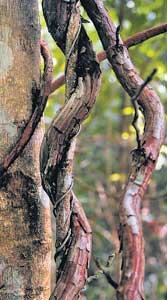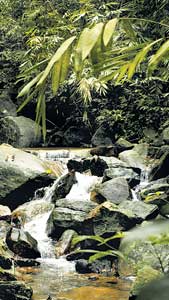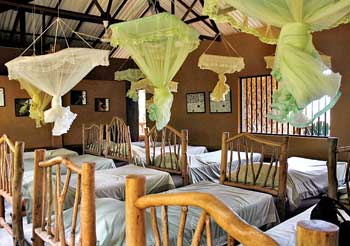
Growing gainsWorld Environment Day falls on June 5. Aplot of land in Ratnapura that was once a neglected rubber plantation has evolved into a flourishing ecological and environmental centre, boasting a wealth of biodiversity and a range of environmental and community activity. The site lies in the foothills of Bambaragala Mookalana, in Kiri-Ella, in the Ratnapura district. Mahausakanda Kele, as the site is known as, is the scene of a pilot project for regenerating a tropical rainforest.
The project was initiated in 2003 by the Ellawala Trust Fund, in collaboration with HSBC. The project serves to both promote the conservation of biodiversity by sustaining endemic species and valuable genetic resources and helping the local community. In 2006, more than 5,000 indigenous plants were introduced to supplement the trees and shrubs already growing in Mahausakanda Kele. Most of these plants have grown to a height of over two metres, thanks to heavy rains. The well-watered region gets an average 3,500mm of annual rainfall. Visitors to Mahausakanda will note the beauty of the site and the variety and richness of the flora and fauna. Three streams descending from Bambaragala Mookalana flow through the site, creating scenic bathing spots, such as Tam Kepu Dola. The rainforest boasts some 200 species of flowering plants, 148 species of vertebrate animals (20 percent of them endemic), and 50 species of butterflies. The birds observed in the area include six species of winter migrants. Some of the trees that grow at Mahausakande are Mesua nagassarium, commonly known as batu na; Vitex altissima (milla); Shorea trapezifolia (thihiniya dun); Artocarpus nobilis (wal del); Harpaulia arborea (na imbul), and Caryota urens (kitul). Freshwater fish found in the streams and ponds of Mahausakande include the Striped Rasbora, the Giant Danio and the endemic Banded Mountain Loach. Apart from the rainforest, Mahausakande is the scene of much community activity, from cottage industries to educational and research programmes. The cottage industries include bees’ honey and kitul treacle production and the making of paper bags and greeting cards from recycled paper.
The education drive involves environmental awareness-raising among the young people of Sabaragamuwa province. The research effort includes the setting up of library and laboratory facilities. These empowering, income-generating community projects are seen as enhancing the physical, social and spiritual wellbeing of the local community. Young women are being trained in handicraft production, and the youth and women of the area are being served by various young people’s societies. Anyone interested in learning more about what is happening in Mahausakanda can stay at the site, at the “Galge” holiday home. Visitors must make advance reservations. However alcohol consumption is not permitted at Mahausakanda. A cultural attraction in the area is the Nedun Rajamaha Viharaya – a shrine-room built of nedun timber and adorned with paintings dating back to the Kandyan era. |
|
||||||
|| Front
Page | News | Editorial | Columns | Sports | Plus | Financial
Times | International | Mirror | TV
Times | Funday
Times || |
| |
Reproduction of articles permitted when used without any alterations to contents and a link to the source page.
|
© Copyright
2008 | Wijeya
Newspapers Ltd.Colombo. Sri Lanka. All Rights Reserved. |


